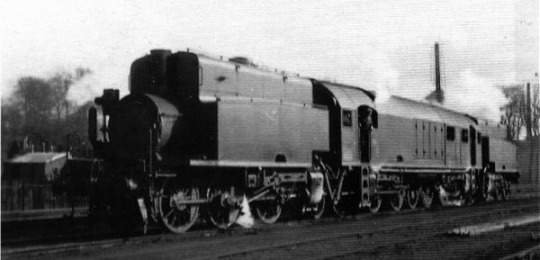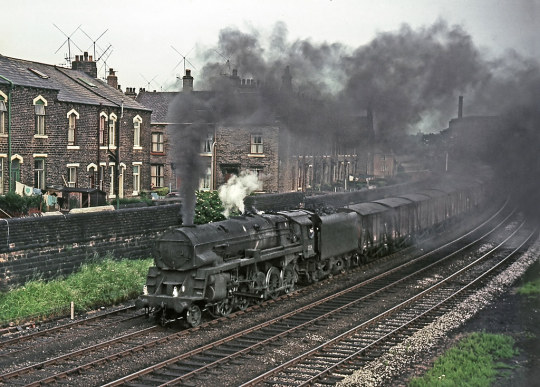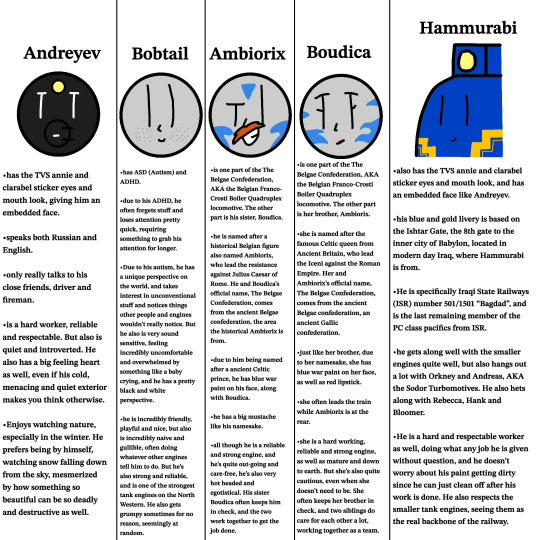#Franco-Crosti Boiler
Explore tagged Tumblr posts
Text
NWR #17 "The Belgae Confederation"

The Belgae Confederation, better known by there individual names of Ambiorix and Boudica, is incredibly large and powerful engine from Belgium, and they are named after the ancient Belgae confederation, while there individual names come from famous ancient Celtic figures. Ambiorix is the more out-going yet hot headed of the two while Boudica is more mature yet cautious, and both are incredibly reliable and hard-working as well. They were built as the Belgian Franco-Crosti Boiler locomotive in 1932 in Tubize, with a 0-6-2+2-4-2-4-2+2-6-0 wheel configuration, making them a quadruplex locomotive. In 1935, they were purchased along with Andreyev, and the engine was used for heavy goods work on the mainline. In 2019, the engine was renumbered from 2096 to 17. They are still working on the mainland today, working together as a unit.
#thomas and friends#thomas and friends au#thomas the tank engine#ttte#ttte AU#ttte oc#belgian#oc#au#belgian Franco-Crosti Boiler locomotive#Franco-Crosti Boiler locomotive#Franco-Crosti Boiler#Belgian Quadruplex#Quadruplex#Quadruplex locomotive#The Belgae Confederation#The Belgae Confederation TTTE#Ambiorix#Ambiorix ttte#boudica#Boudica ttte
0 notes
Note
This one goes out to all the 9f’s out there who wish to answer and because they should get some love too.
What was it like during the 1950s up until the end of steam?
Was there a “leader/s” of your class like SirNigel or Pretty Polly was?
Finally what was the Franco-Crosti boilers like?
BLACK PRINCE: Hello there. Thank you for the question. I'll answer this question for you unless you were hoping for another of my classes to answer for you.
The end of steam was filled with anxiety and backstabbing. Many engines turned on each other because in those days if you came up with a fault there was a high chance that you would be written off and sent to the scrapyard.
Many engines sold others out, even their siblings for the chance to be preserved. Previously nice engines turned desperate and vicious all for a chance to be preserved. My little Sister, Evening Star, was preserved off the production line and she was bullied into selective mutism.
Yes, there were leaders of almost every class and I am proud to say that I was the leader of the 9fs. That does not say much as I allowed Evening Star to be bullied.
Franco-Crosti boilers are the only boilers to have. Why settle for less than the best?
17 notes
·
View notes
Text
Hey italy...
Hey!
what the FUCK

is this???
(Italian Type 683 locomotive with Franco-Crosti boiler pre-heaters)
(@steam-butch this one's for you)
7 notes
·
View notes
Text
Thomas OCs: Michael

Number: 50 (ex-BR #92028) Class: BR Standard 9F 2-10-0 Built: 1955 Arrived on Sodor: 1965 Service (Shed): NWR Main Line (Barrow-In-Furness) Livery: NWR Goods Black
Most people will have heard of Murdoch, but what may not be so well-known is that he’s not the only 9F on the NWR’s books. He wasn’t even the first 9F to arrive on the railway. That honour, on both counts, goes to Michael. And if Murdoch’s the thinker of the pair, then Michael’s very much the doer. He doesn't care how the job is done, as long as it's done. This means that he'll sometimes have to break a few rules to get the job done, and this has gotten him into trouble on more than one occasion. Michael is also very much more extroverted than Murdoch, and this has definitely caused some friction between the two in the past.
Michael was built at Crewe Works in 1955, as part of an experimental batch of ten 9Fs fitted with boilers of the Franco-Crosti pattern. In a conventional boiler, exhaust gasses passing through the boiler are expelled through the funnel as waste heat. A Franco-Crosti boiler takes these gasses, and passes them through what is essentially a secondary boiler. They’re then used to preheat the feedwater before it goes into the main boiler. This system had been tried out in Europe, and proven especially successful in Italy, and it was hoped that similar success would be had in Britain.
After being outshopped at Crewe, Michael was allocated to Wellingborough MPD, from which he was put to work on heavy goods trains up and down the Midland Main Line. It is also recorded, however, that Michael paid a visit to Brighton Works in September 1955 - the exact reason is unknown, but this was most likely so that the workshop staff could become acquainted with the modified design of the Franco-Crosti engines. This is odd, as there is no similar evidence of any of the conventional 9Fs, let alone any of the modified ones, ever being allocated to the Southern Region.
Although Michael performed well enough, the experiment didn’t bear as much fruit as had been hoped. For one thing, the boiler had had to be reduced in diameter to accommodate the feedwater heater, and so the 9Fs thus fitted were, if anything, less powerful than their conventional counterparts. The heater also provided only a marginal increase in thermal efficiency - too marginal, in fact, to justify the cost and complexity of the endeavour. By far the biggest problem, from the crew’s perspective, was the secondary chimney for the heater, located on the right-hand side of the main boiler. The smoke coming from this obstructed the crew’s view on this side, and frequently made for unpleasant conditions in the cab.
All these faults lead BR to declare the experiment a failure - with the end of steam in sight, they decided it wasn’t worth carrying on with the experiments. The Franco-Crosti engines had their feedwater heaters sealed off, effectively making them conventional 9Fs again. Michael himself received such a modification in 1959, and he continued working on the Midland Main Line, out of a succession of different depots, for the next few years.
In August 1965, Michael - now based at Banbury - became the first of the former Franco-Crosti engines to be withdrawn from BR service. Given that he was effectively a non-standard design, Michael was almost certain that the end wasn’t far off. But he was wrong. An intended movement to the scrapyard was instead turned into a transfer to the NWR. This turned out to be part of Sir Topham Hatt’s scheme to bring as many steam engines to Sodor as he could, while he was still able to.
Michael arrived on Sodor at the end of August, was fixed up by Crovan’s Gate during September, and finally entered NWR service in October that same year. He was allocated to the NWR’s sheds at Barrow-In-Furness, from which he would work heavy express freights between Sodor and the Mainland - as such, he tended to travel much further than other NWR engines, until such services were curtailed following BR’s Steam Ban in 1968.
In 1975, Michael’s world was shaken up when another 9F entered service on the NWR - this being Murdoch, of course. Despite their shared lineage, the two did not see eye-to-eye at all to begin with, with Murdoch finding Michael too hard on the ears, and Michael finding Murdoch too hard on the eyes (that is, he found Murdoch’s golden-orange livery to be an eyesore). The arguments nearly developed into an all-out fight, but luckily, Sir Topham Hatt had anticipated this: He rostered both engines onto a heavy goods train that required both of them to work together. This seemed to do the trick, and with a newfound appreciation for each other’s quirks, Murdoch and Michael agreed to bury the hatchet and only let their rivalry manifest in mild bickering.
Since then, Michael has remained a formidable and distinctive sight on the Main Line, becoming a vital asset to the heavy goods link. Although he rarely travels beyond Barrow-In-Furness these days, he still manages to make his mark on the NWR, and he’s also a good friend to have - provided you can shut him up long enough to get a word in!
Trivia
As I’ve mentioned before, I’ve used a number of characters from the Extended Railway Series as starting points for some of my own OCs - starting with the ERS character, boiling them down to their most basic details, and then changing each detail slightly until they’re a completely different character. That’s pretty much what I did with Michael here, who was of course inspired by the ERS character Samarkand - alias Sammie.
The reason I specifically went with a Franco-Crosti 9F was to visually set Michael apart from Murdoch. And, as always, I thought the design looked suitably unusual, and therefore interesting. The NWR is already chock-full of freaks, weirdos and outcasts, so it stands to reason that they’d also have an engine of this class.
The name Michael, while unusually generic by my standards, was chosen specifically to link him with Murdoch. Gotta love those alliterative names. And I think a mundane name provides a suitably ironic contrast to the unusual nature of his design.
#thomas the tank engine#the railway series#sodor#island of sodor#north western railway#ttte headcanon#ttte analysis#ttte oc#original character#michael the franco-crosti engine
5 notes
·
View notes
Text

The British Railways (BR) Standard Class 9F 2-10-0 is a class of steam locomotive designed for British Railways by Robert Riddles. The Class 9F was the last in a series of standardised locomotive classes designed for British Railways during the 1950s, and was intended for use on fast, heavy freight trains over long distances. It was one of the most powerful steam locomotive types ever built for British Railways, and successfully performed its intended duties. The class was given the nickname of 'Spaceships', due to its size and shape. In 1955 BR experimentally built 10 9F's at Crewe Works; these 10 were fitted with Franco-Crosti boilers. The Franco–Crosti boiler is a type of boiler used for steam locomotives. It was designed in the 1930s by Attilio Franco and Dr Piero Crosti. The main difference between it and conventional feedwater heaters widely used on the continent is that the Franco-Crosti boiler uses both exhaust steam and exhaust gases from the firebox. Conventional feedwater heaters only use exhaust steam. The Franco-Crosti boiler took the form of a single cylindrical water drum running along the underside of the main boiler barrel; the standard chimney at the front was only used during lighting-up, in normal working the gases went through firetubes inside the preheater drum that led to a second smokebox situated beneath the boiler from which there emerged a chimney on the right-hand side, just forward of the firebox. However; the experiment did not deliver the hoped-for benefits, and efficiency was not increased sufficiently enough to justify the cost and complexity. Moreover, conditions were unpleasant on the footplate in a cross-wind, this in spite the later provision of a small deflector plate forward of the chimney. These problems led to the subsequent sealing off of the preheater drum, over the period of 1959 to 1961, and the locomotives were then worked conventionally. As a result of this, there was a reduced ability to generate steam, and so their power classification was reduced from 9F to 8F. No. 92028 was the first Franco-Crosti 9F to be withdrawn in October of 1966, No. 92027 followed in August of 1967, with the remainder being withdrawn en masse in November of 1967. All were scrapped, with none surviving into preservation.
#locomotive#train#trains#steam locomotive#british railways#br#franco-crosti#9f#failed experiment#experimental#crewe works
42 notes
·
View notes
Text

Here’s some extra trivia on some new OCs from my Thomas AU. And what there faces look like.
#thomas and friends#thomas and friends au#thomas the tank engine#ttte#ttte au#ttte oc#oc#AU#AA20#Andreyev TTTE#Bobtail ttte#the Belgae confederation ttte#Ambiorix ttte#Boudica ttte#Hammurabi ttte#NZR WW Class#Belgian Franco-Crosti Boiler locomotive#Belgian Quadruplex#Iraqi state railways PC class#AA20 locomotive
0 notes